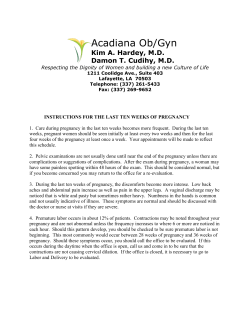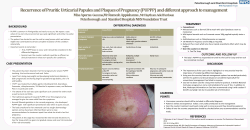
Who is this summary for?
Evidence assessment: Summary of a systematic review Who is this summary for? This evidence assessment is meant for clinicians, administrators of health facilities and decision makers. Telephone support for women during pregnancy and the first six weeks after delivery Key findings Telephone support may increase women’s overall satisfaction with their care during pregnancy and the after delivery. The use of telephone communication may increase the duration of breastfeeding. The babies whose mothers received support may be less likely to be admitted to a neonatal intensive care unit. Background Telephone communication is increasingly being accepted as a useful form of support for health care. There is some evidence thattelephone support may be of benefit in specific areas of maternal care such as to support breastfeeding and for women at risk ofdepression. Many telephone-based interventions are currently being used in maternity care. It is of interest to examinewhich interventions may be of benefit, which are ineffective, and which may be harmful. Question What is the effect of telephone support during pregnancy and the first six weeks after delivery compared with routine care, on maternaland infant outcomes? The use of telephone for women during pregnancy and postpartum in Cameroon: Telephones are not routinely used to support the provision of health care during pregnancy and after delivery. However, less than average satisfaction with care during pregnancy and after delivery suggest that there is room for improvement. Table 1: Summary of the systematic review What the review authors searched for What the review authors found Studies Randomized controlled trials (RCTs) and Twenty-nine trials met the inclusion criteria cluster RCTs. for the review. Participants Pregnant women and postnatal women in the Thepregnant women or women in the early first six weeks after delivery. postpartumperiod (up to six weeks postpartum) Interventions All interventions aimed at supportingwomen Nine of the trials were designed to support by using telephones,whether for general breastfeeding women.Six studies aimed to support/information or for a specific encourage women to quit smoking, or to medical/social reason (e.g. diabetes, smoking). preventsmoking relapse. Two trials focused This includes studieswhere the intervention is specifically on women at high risk of introduced in pregnancy or in the first postnataldepression. sixweeks after delivery or both. Two studies focused on women who were at Interventionsmay have been in any setting and high risk of pretermbirth and in both of these delivered by healthcare staff,peer supporters trialswomenreceived phone calls during or using automated messaging. pregnancy from trained staff.Six of the studies examined more general telephone support interventions. Controls No controls specified No controls specified Outcomes Primary outcomes Four studies provided data onmaternal 1. Maternal satisfaction with support during satisfaction with support during pregnancy and pregnancy andthe first six months postpartum thefirst six weeks post-partumfour reported 2. Maternal anxiety on aternal anxiety, twoonhealth service Secondary outcomes utilization, twoonpostpartum depression, Maternal outcomes seven on smoking reduction. 1. Mother-infant attachment. 2. General health 3. Mortality and serious morbidity (e.g. perinealhaematomaor deep surgical infection). 4. Health service utilisation5. Postpartum depression 6. Positive behavior change e.g.smoking reduction). Infant outcomes 1. Preterm birth/low birthweight. 2. Breastfeeding duration 3. Infant developmental measures (physical and cognitive as) 4. Neonatal/infant mortality. 5. Major neonatal/infant morbidity (e.g. prolonged admission to special care baby unit). Date of the most recent search: 23 January 2013 Limitations:This is a good quality systematic review. Due to the wide variety of outcomes it was challenging to pool many of the included studies. Citation:Lavender T, Richens Y, Milan SJ, Smyth RMD, Dowswell T. Telephone support for women during pregnancy and the first six weeks postpartum. Cochrane Database of Systematic Reviews 2013, Issue 7. Art. No.: CD009338. DOI: 10.1002/14651858.CD009338.pub2.No.: CD003543. DOI: 10.1002/14651858.CD003543.pub3. 2 Summary of Findings Outcomes Relative effect (95% CI) Maternal satisfaction with support during pregnancy and the first six months postpartum Maternalanxiety 1.16 (0.79 to 1.54) General health Health service utilisation Positive behaviour change (smoking reduction) Postpartum depression Preterm birth/low birth weight No of participants (studies) 132 (2 studies) -0.09 (0.29 to 0.11) 0.93(0.72 to 1.21) 386 (2 studies) 0.24(-0.26 to 0.74) 1.12 ( 0.87 to 1.44) 563 (2 studies) 0.65 (0.34 to 1.23) 0.91 (0.77 to 1.08) 37 (1 study) 1361 (4 studies) 612 (1 study) 3992 (4 studies) Quality of the evidence (GRADE) ⊕⊕⊝⊝ Low ⊕⊕⊝⊝ Low ⊕⊕⊝⊝ Low ⊕⊕⊝⊝ Low ⊕⊕⊝⊝ Low ⊕⊕⊝⊝ Low ⊕⊕⊝⊝ Low Comments Most of the results of this review are derived from one or twostudies and several of the studies had small sample sizes; the authors wereunable to pool most of the data. The outcomes and the way they were reported was not consistent. Applicability In this review13 of the studies were conductedout in the USA, 5 in Canada, 2 in Australia, 2 in England, and 1 each in Thailand, New Zealand, Italy, Tanzania and Scotland.Even though only one of these studies was conducted in Africa, some of these interventions can easily be applied in low resource settings. Conclusions Despite some encouraging findings, there is insufficient evidence to recommend routine telephone support for women accessing maternity services, as the evidence from included trials is neither strong nor consistent. Although benefits were found in terms of reduced depression scores, breastfeeding duration and increased overall satisfaction, the current trials do not provide strong enough evidence to warrant investment in resources. Prepared by Marius Vouking, Violette Tamo, Christine Danielle Evina,Lawrence Mbuagbaw, Pierre OngoloZogo:Centre for the Development of Best Practices in Health, Yaoundé, Cameroon. August 2013 3
© Copyright 2025





















